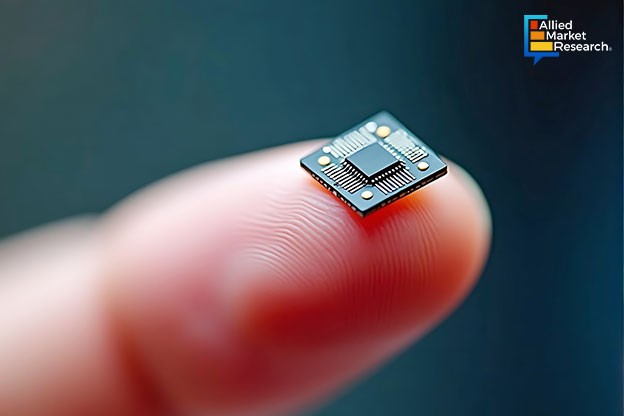Smart Dust: How Is This Technology Boosting Industrial Operations with Greater Efficiency and Safety?

6 Dec
2024
Highlights:
- A brief on smart dust technology
- Notable use cases of smart dust in different sectors
- Recent developments in the domain
Smart dust refers to a network of tiny, wireless sensors, often not larger than a grain of sand, designed for various sensing, computing, and communication tasks. These microelectromechanical systems (MEMS) monitor environmental conditions such as temperature, humidity, light, and chemical compositions. The concept emerged from research initiatives in the 1990s and has evolved into a promising technology with potential applications across multiple sectors.
Smart dust devices are typically millimeter-sized grains that integrate sensing capabilities, communication technology, and power supplies into a compact form. This miniaturization is achieved through advanced manufacturing techniques, including 3D printing and MEMS technology. These sensors communicate wirelessly, often using radio-frequency identification or optical transmission methods. They transmit data over short distances, enabling real-time monitoring and data collection. A significant challenge in smart dust development is energy efficiency. Many smart dust devices utilize low-power consumption strategies, such as sleep modes and energy harvesting techniques such as solar panels, to extend their operational lifespan.
The penetration of smart dust technology across various industries
Smart dust technology is widely used in a wide range of applications across various sectors. It has revolutionized the agriculture sector by enabling constant monitoring of the nutritional needs of crops, including watering, fertilization, and pest management. These tiny sensors are deployed throughout fields, providing farmers with real-time data that enhances decision-making processes and optimizes resource use. Nowadays, farmers are able to significantly improve crop yield and quality by analyzing this information.
While traditional AI systems often rely on computer vision for tasks such as detecting pests and assessing fruit ripeness, smart dust offers a more nuanced approach. Unlike robots that use cameras to identify ripe fruits or detect diseases, smart dust sensors gather comprehensive data on soil conditions and plant health, potentially outperforming human capabilities in these areas. This shift toward precision agriculture automates labor-intensive tasks and facilitates more effective interventions on the basis of detailed insights into crop conditions. As smart dust integrates with IoT and AI technologies, it represents a significant advancement in agricultural practices, allowing sustainable farming methods that minimize waste and environmental impact. The future of farming could be defined by these interconnected systems, leading to smarter, more efficient agricultural strategies.
Moreover, this cutting-edge technology offers significant potential for monitoring industrial processes, particularly in managing dust emissions produced by manufacturers. The Dustroid dust monitoring system, which is MCERTS certified, provides real-time, accurate data essential for effective dust management. With the help of these systems, companies identify issues such as cracks in machinery or leaks in tanks long before they impact performance by deploying large-scale sensor networks.
This proactive approach allows manufacturers to make informed decisions on the basis of continuous monitoring, enhancing operational efficiency and safety. The ability to receive immediate alerts when dust levels rise enables the implementation of automated mitigation systems, such as water misters, to maintain air quality. As industries increasingly focus on compliance with environmental regulations and improving workplace safety, smart dust systems such as Dustroid become invaluable tools for ensuring a healthier environment while optimizing industrial operations.
How is smart dust technology transforming healthcare?
The smart dust market has experienced notable growth due to its rising role in redefining the healthcare industry through its use of miniaturized sensors for health monitoring applications. These tiny sensors, comparable in size to a grain of sand, enable continuous tracking of vital signs such as heart rate, blood pressure, and glucose levels. Their small size allows non-invasive monitoring, making it possible to embed them within the body or integrate them into wearable devices.
This capability facilitates real-time health monitoring, allowing healthcare providers to detect abnormalities early and intervene promptly. In addition, smart dust enhances drug delivery systems by providing precise control over medication release, optimizing treatment efficacy while minimizing side effects. As a result, smart dust improves patient care and paves the way for personalized medicine approaches. The healthcare sector achieves greater efficiency and effectiveness in managing chronic diseases and overall patient health by utilizing this technology.
Donaldson’s new smart dust collector
In April 2024, Donaldson Company, Inc., a leading provider of engine and industrial air, oil and liquid filtration solutions, introduced the Dalamatic G2 smart collector, which is engineered to work with materials that create sticky or agglomerative dust. The Dalamatic G2 dust collector includes patented Dura-Life bag filters that allow greater bag movement and provide twice the life of a standard 16-oz. polyester bag. The system’s radial seal filter design and fixed cages help reduce the time for filter changeouts by up to 75%, compared to earlier designs. The filters contribute to improved pulse cleaning, which results in extended bag life, less maintenance, and energy savings. According to the company, this collector represents next-generation solution for industries to capture challenging dust.
In a nutshell
Smart dust showcasesa revolutionary advancement in sensor technology with the potential to transform various industries through enhanced data collection and monitoring capabilities. Moreover, increase in demand for innovative technologies in healthcare, industrial monitoring, and space exploration is expected to open new possibilities across the sector in the future.
To gain more insights into the upcoming trends in the smart dust industry, reach out to our industry specialists here!

Rosy Behera
Author's Bio- Rosy Behera holds a bachelor’s degree in Electrical and Electronics Engineering and now she is a content writer by profession. She loves to portray her thoughts and ideas with a nice command of words. Grabbing an audience with her creative write-ups is one of her biggest assets so far. Apart from writing, she is a certified “Odisi” dancer and has done Gardharva in Drawing, Painting, and Arts. She always explores new things through travel and is a big foodie.
Avenue: Entire Library membership of Allied Market Research Reports at your disposal
- Avenue is an innovative subscription-based online report database.
- Avail an online access to the entire library of syndicated reports on more than 2,000 niche industries and company profiles on more than 12,000 firms across 11 domains.
- A cost-effective model tailored for entrepreneurs, investors, and students & researchers at universities.
- Request customizations, suggest new reports, and avail analyst support as per your requirements.
- Get an access to the library of reports at any time from any device and anywhere.
Related Post
-
How are Submarine Cables Transforming Global Connectivity with Enhanced User Experience?
-
Endoscopy Procedures: Transformations in Techniques and Applications
-
AI-Powered Video Analytics: How the Product Actually Works for enterprises
-
Painting Robots: Transforming Precision Coating and Creative Applications
-
Innovations in Pharmacovigilance Systems Advancing Patient Safety
-
Understanding Edge Security: Keeping Data Safe Near the Source
-
Exploring the Use and Advancements of 3D Laser Scanners in Professional Applications
-
Reinforcing Industrial Controls with Smarter Tools and Training








